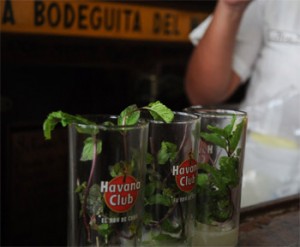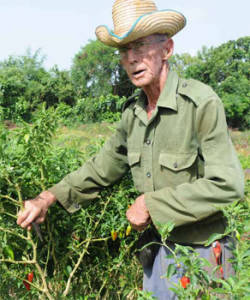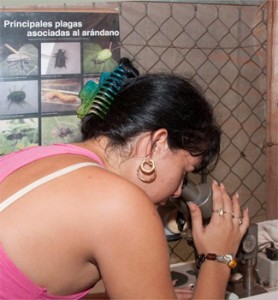Cuba: The Mojito Secret & Urban Farming
Organic and Sustainable Urban Agriculture

HAVANA TIMES — Ernest Hemingway recommended drinking the mojitos at the Bodeguita del Medio bar, so we tried to find out why. The bartender, Reynaldo Linea — who turned out to be a regular BBC reader — revealed the origin of the mint they use.
It comes from an urban agricultural cooperative that only produces organic foods. This means the mint is always fresh, since the close proximity of the farm allows it to be delivered daily. Like they say, it goes directly from the furrow into the glass.
“The mint was always lacking, at least until the ministers of Agriculture and Tourism signed an agreement to ensure its supply to the Bodeguita del Medio,” explained Reynaldo, who has worked behind the bar for 22 years.
Recent economic reforms now allow the famous restaurant to buy top quality mint directly from growers, with payment made in hard currency that helps further develop their cooperatives.
From the desk to the fields
The farm is located in Havana’s Alamar worker housing suburb, only 15 minutes by car from the Bodeguita, so we went straight there to talk to the growers. Upon our arrival we found a stand selling vegetables, spices and other produce to the nearby residents at prices lower than in the city’s markets.

Miguel Salcines is an agricultural technician who worked for years at the Ministry of Agriculture. He was one of the few people who, during the economic crisis of the ‘90s, chose to leave that agency and become involved in food production. Along with three or four other people, and using vacant land, he founded the cooperative.
“It was a challenge. We were a country of large monoculture tracts that didn’t take into account small-scale agriculture,” said Miguel, but he added that this immediately became a source of employment for the community – primarily for “women and seniors.”
Food shortages during the ‘90s crisis forced even the most reluctant individuals to try eating vegetables from the cooperative, and “people gradually incorporated them into their diets. In this way we contributed to creating different consumption habits that still remain today.”
Natural cycles

One-hundred and sixty people work on the farm. Indeed, “Its greatest strength is its human resources and our workers’ level of training. We have 22 university graduates, more than 40 middle-level technicians and the rest have between 9th and 12th grade educations. The average age is around 50,” explained Miguel.
The oldest of these workers is Jose Luis Roche, an 81-year-old grandfather who has spent 70 years in agriculture. So that he can “talk a little while with the other members,” he gets to work every day at around 6:00 a.m., an hour earlier than required. He assured us that “work is good for you; what’s bad is sitting around.”
Another worker, 24-year-old Roxana Fleites, is in charge of a biology lab located in a palm-roofed shed in the middle of the cooperative. She says they don’t use chemicals; instead, “We reproduce beneficial insects and raise parrot chicks that eat pests.”
They have managed to become self-sustaining based on a system of organic production that is free of chemicals and which “combine natural cycles.” They raise cows and use their droppings to produce worm humus (vermicompost) and then apply this to the land as a natural fertilizer.
Farmers and shareholders
Michael assures us that the work carried out in the cooperative is more human than in large-scale agriculture. As he put it, “The workday is shorter, since we put in only six hours a day in the summer and seven in the winter; plus, we make zero-interest loans to our members, and we get free lunch and dinner.”

Despite all this, it took some work to retain their members. They had to create a pay system that combines wages and stocks, with the latter being capitalized based on the “working capital” accumulated by each cooperative member. “Fifty percent of the profits are divided between the shareholders.”
New employees work as employees for their first three months, and — if the assembly approves their membership into the cooperative — they begin accumulating capital in the fields. The first year they receive one share and they continue getting more until they accumulate six shares by their tenth year.
The basic salary of a cooperative member is 350 to 700 pesos a month (about $15 to $30 USD), but added to this are their shares, which can reach up to 2,000 pesos a month (about $80 USD). Moreover, “unlike other cooperatives, we don’t hold onto the profits for months; these are paid out along with the worker’s wages every 15 days.”
“What doesn’t grow dies”
Miguel Salcines explained that they have received support from European NGOs, Cuban research centers and from the local government, but they ran into the bureaucratic obstacles that have impeded agricultural development across the nation for decades.
“Marketing policies sought to protect the population against food speculation, but these created a lot of rigidity in pricing, which is something that doesn’t stimulate production. We hold the view that the country should be subsidizing [needy] people – not products.”
“The system for purchasing supplies and resources is extremely complex; it’s done through other companies and other offices with contracts and a sea of paperwork that aren’t responsive to our immediate needs, like when a truck breaks down, for example.”
“They also refuse to allow us to get involved in other activities on the fringes of farming, for example starting a restaurant or a café. And that kills the capital that we have for investing as a cooperative – because what doesn’t grow, dies.”
—–
(*) A Havana Times translation of the original published by Cartasdesdecuba.com.

I am absolutely stunned by this article! Thanks, Fernando.
This coop illustrates several important concepts for the development or perfection of Cuban socialism. One is the critical function of the originating “cooperative entrepreneur.” In this case it is Miguel Salcines, but it could be anyone–or any leadership group–in any industrial or commercial sector.
Another important concept is the organic unity of moral and material interests among working associates. Socialism cannot be misconceived as being against material interests. (A workers’ strike under capitalism is usually to defend the material interests of workers, and no socialist would ever be against that!)
In the case of this agricultural cooperative, the working people themselves, with good leadership and a socialist cooperative business model, have established a successful and exemplary socialist enterprise under socialist state power. I think that the PCC should generalize from it, and apply its lessons creatively in other economic sectors.